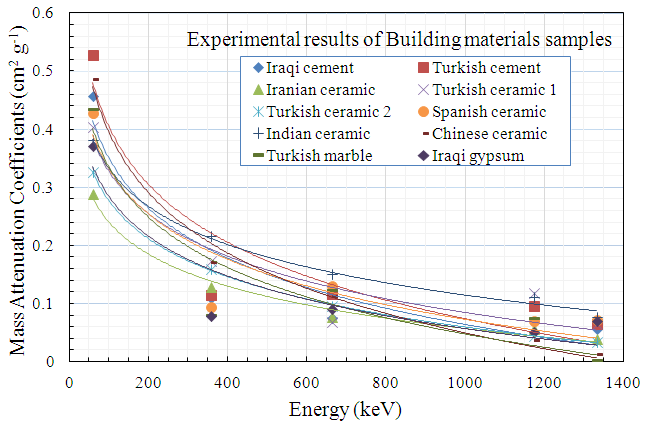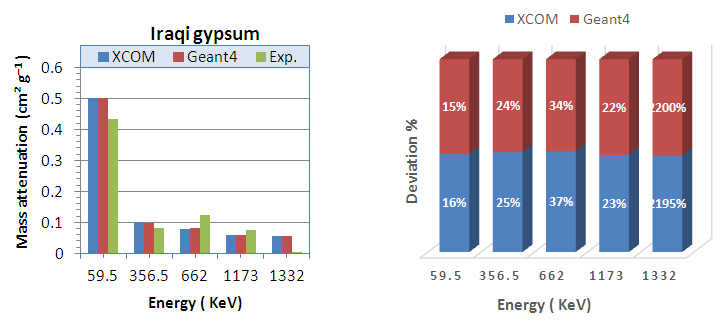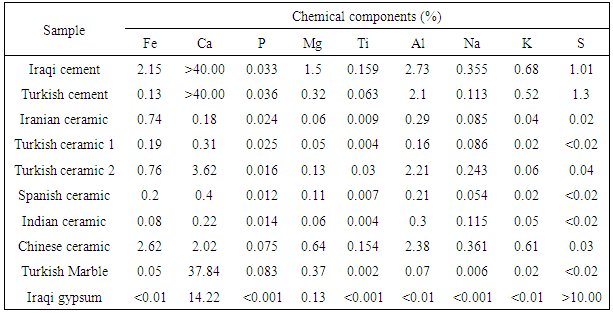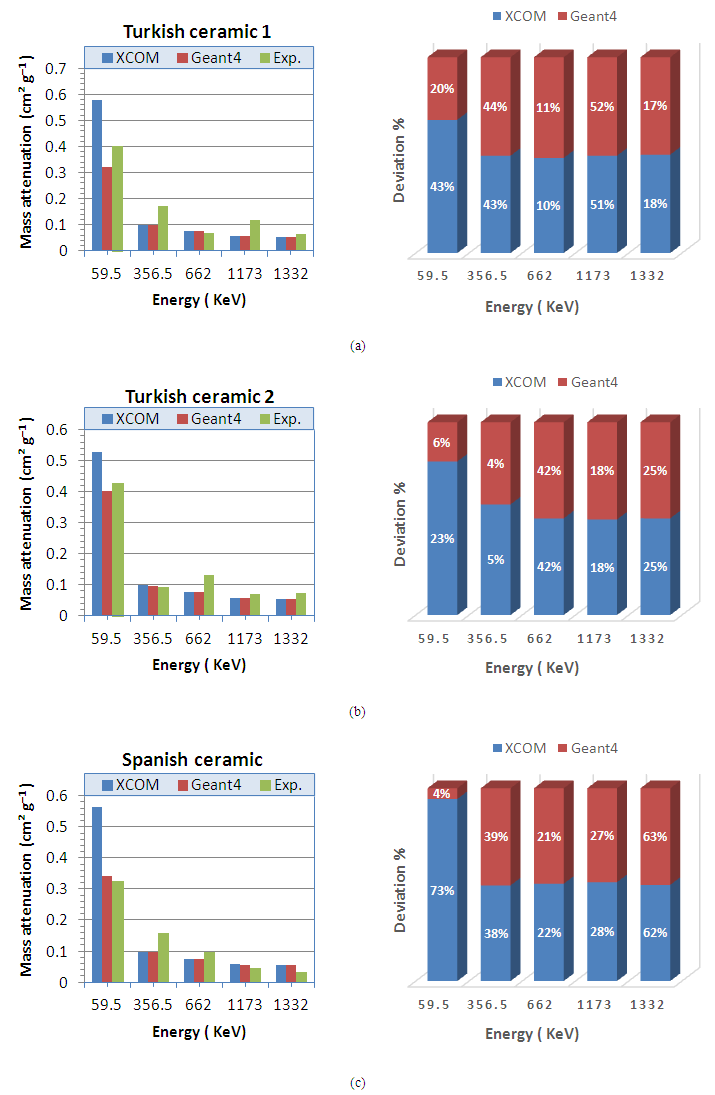-
Paper Information
- Paper Submission
-
Journal Information
- About This Journal
- Editorial Board
- Current Issue
- Archive
- Author Guidelines
- Contact Us
Journal of Nuclear and Particle Physics
p-ISSN: 2167-6895 e-ISSN: 2167-6909
2017; 7(1): 6-13
doi:10.5923/j.jnpp.20170701.02

Experimental and Theoretical Investigation of Gamma Attenuation of Building Materials
Ali H. Taqi , Hero J. Khalil
Department of Physics, College of Science, Kirkuk University, Kirkuk, Iraq
Correspondence to: Ali H. Taqi , Department of Physics, College of Science, Kirkuk University, Kirkuk, Iraq.
| Email: |  |
Copyright © 2017 Scientific & Academic Publishing. All Rights Reserved.
This work is licensed under the Creative Commons Attribution International License (CC BY).
http://creativecommons.org/licenses/by/4.0/

In this paper, the gamma mass attenuation coefficient is investigated experimentally and theoretically for samples of building materials available in Iraq with different origins. Mass attenuation coefficients were measured using shielded NaI (Tl) spectrometer detector. Samples were irradiated by gamma-rays emitted from point sources of 241Am, 133Ba, 137Cs and 60Co and. The measured results were compared with the theoretical calculations of XCOM and Geant4 codes, and agreements have been observed especially for Monte Carlo simulations code Geant4.
Keywords: Mass attenuation coefficients, Genat4, XCOM
Cite this paper: Ali H. Taqi , Hero J. Khalil , Experimental and Theoretical Investigation of Gamma Attenuation of Building Materials, Journal of Nuclear and Particle Physics, Vol. 7 No. 1, 2017, pp. 6-13. doi: 10.5923/j.jnpp.20170701.02.
Article Outline
1. Introduction
- When radiation passes through any material, its intensity gradually reduces as a result of a series of interactions. The linear attenuation coefficient µ, which is defined as the probability of a radiation interacting with a material per unit path length (Woods, 1982). it is the important quantity characterizing the penetration and diffusion of gamma radiation in a medium. The mass attenuation coefficient
 is essential parameter to derive several other parameters of shielding, radiation interaction and dosimetry and etc. It a measure of γ-rays absorption or scattering. The magnitude of attenuation coefficients depends on the incident photon energy, the atomic number and the density of the materials. Recently many researchers have been studied on determination of mass attenuation coefficients theoretically and experimentally for different materials. A more detailed surveys and exhaustive list of references can be found in (Han and Demir, 2009).Several experimental and theoretical studies have been conducted on the effects of different factors on the mass attenuation coefficients of building materials. For example, Medhat (2009) has measured gamma-ray attenuation coefficients of some building materials available in Egypt. Singh et al. (2008) have been calculated attenuation coefficients of barium-borate fly ash glasses as a shielding of radiation instead of concrete. Turkmen et al. (2008) have calculated attenuation coefficients in Portland cements mixed with silica fume, blast furnace slag and natural zeolite over the range of 1-2000 keV. Awadallah and Imran (2007) have measured γ-ray attenuation coefficients in Jordanian building materials. Salinas et al. (2006) have calculated the effective density and mass attenuation coefficients for several building materials in Brazil. Akkurt et al. (2005) have studied the shielding of γ-rays by concretes produced with barite. Akkurt et al. (2004) have calculated attenuation coefficients of barite, marble and limra in Turkey. Singh et al. (2004) have calculated mass attenuation coefficients for building materials in India. Alam et al. (2001) have measured the attenuation coefficients for soil samples and building materials in Bangladesh. Bashter (1997) has calculated the attenuation coefficient for different types of shielding concrete. Meckbach et al. (1987) have used Monte Carlo method to study shielding of γ-radiation by typical European houses.In this work, the mass attenuation coefficients of building materials samples have been investigated experimentally and theoretically by using XCOM code and Monte Carlo simulation code Geant4 for the photons of the energies 59.5, 356.5, 662, 1173, and 1332 keV. The building material samples available in Iraq with different origins. To evaluate the availability of the codes, the comparison of the simulation results with the experiments are presented.
is essential parameter to derive several other parameters of shielding, radiation interaction and dosimetry and etc. It a measure of γ-rays absorption or scattering. The magnitude of attenuation coefficients depends on the incident photon energy, the atomic number and the density of the materials. Recently many researchers have been studied on determination of mass attenuation coefficients theoretically and experimentally for different materials. A more detailed surveys and exhaustive list of references can be found in (Han and Demir, 2009).Several experimental and theoretical studies have been conducted on the effects of different factors on the mass attenuation coefficients of building materials. For example, Medhat (2009) has measured gamma-ray attenuation coefficients of some building materials available in Egypt. Singh et al. (2008) have been calculated attenuation coefficients of barium-borate fly ash glasses as a shielding of radiation instead of concrete. Turkmen et al. (2008) have calculated attenuation coefficients in Portland cements mixed with silica fume, blast furnace slag and natural zeolite over the range of 1-2000 keV. Awadallah and Imran (2007) have measured γ-ray attenuation coefficients in Jordanian building materials. Salinas et al. (2006) have calculated the effective density and mass attenuation coefficients for several building materials in Brazil. Akkurt et al. (2005) have studied the shielding of γ-rays by concretes produced with barite. Akkurt et al. (2004) have calculated attenuation coefficients of barite, marble and limra in Turkey. Singh et al. (2004) have calculated mass attenuation coefficients for building materials in India. Alam et al. (2001) have measured the attenuation coefficients for soil samples and building materials in Bangladesh. Bashter (1997) has calculated the attenuation coefficient for different types of shielding concrete. Meckbach et al. (1987) have used Monte Carlo method to study shielding of γ-radiation by typical European houses.In this work, the mass attenuation coefficients of building materials samples have been investigated experimentally and theoretically by using XCOM code and Monte Carlo simulation code Geant4 for the photons of the energies 59.5, 356.5, 662, 1173, and 1332 keV. The building material samples available in Iraq with different origins. To evaluate the availability of the codes, the comparison of the simulation results with the experiments are presented.2. Gamma Attenuation Simulation
- The calculations of the mass attenuation coefficients is based on the Beer-Lambert law (Davisson, 1965),
 | (1) |
 and
and  are the attenuated and incident photon intensities, respectively, x(cm) and
are the attenuated and incident photon intensities, respectively, x(cm) and  are the thickness and density of the material. The mass attenuation coefficient
are the thickness and density of the material. The mass attenuation coefficient  is slope of a straight line equation,
is slope of a straight line equation, | (2) |
 | (3) |
 is the proportion by weight and
is the proportion by weight and  is mass attenuation coefficient of the ith element. In XCOM code, the cross-sections and attenuation coefficients for elements, compound or mixtures can be calculated in the energy range between 1 keV and 100 GeV (Berger, 2010). The Monte Carlo simulation code Geant4 is modeling of the photon attenuation through materials in computer environment provides flexibility and ease of use, instead of performing an experimental determination of
is mass attenuation coefficient of the ith element. In XCOM code, the cross-sections and attenuation coefficients for elements, compound or mixtures can be calculated in the energy range between 1 keV and 100 GeV (Berger, 2010). The Monte Carlo simulation code Geant4 is modeling of the photon attenuation through materials in computer environment provides flexibility and ease of use, instead of performing an experimental determination of  values of different composite materials or mixtures. The Geant4 code covers a wide energy range starting from 250 eV to TeV (CERN, 2007; Agostinelli et al., 2003).
values of different composite materials or mixtures. The Geant4 code covers a wide energy range starting from 250 eV to TeV (CERN, 2007; Agostinelli et al., 2003).3. Experiment
- The investigated building materials are available in Iraq with different origins and they are used in construction. A 500 mm mesh was used to sieve the investigated samples, and the drying temperature was set to 110°C for 24h to ensure that any significant moisture was removed. Inductively Coupled Plasma Mass Spectrometry or ICP-MS (Greenfield, 1994) is used to obtain chemical components of the samples. A cylindrical plastic container of internal diameter 3 cm and height 4 cm was placed between detector and sources. The collimator of aperture diameter 3 mm were used to ensure that the NaI detector absorbs a narrow beam of gamma rays after passing through the test column. The whole system was enclosed in lead shielding (5 cm lead, 0.5 cm copper, 0.5 steel) to reduce background counts. The experimental arrangement is as shown in Fig. 1.
 | Figure 1. Experimental setup for measuring gamma attenuation coefficients |
 versus thickness of the sample
versus thickness of the sample  are plotted, the slope of the absorption graph gives the experimental gamma-ray mass attenuation coefficient of the investigated samples in terms of cm2 g-1.
are plotted, the slope of the absorption graph gives the experimental gamma-ray mass attenuation coefficient of the investigated samples in terms of cm2 g-1.4. Result and Discussion
- Some of chemical components of the investigated samples are given in Table 1. Fig. 2, shows an experimental results of mass attenuation curve of energies 59.5 keV, 356.5 keV, 662 keV, 1173 keV and 1332 keV for the investigated samples. The theroretical calculation of mass attenuation coefficients of samples are carried out by Geant4 Monte Carlo simulation code and XCOM program at the above photon energies. The mass attenuation coefficient of Geant4 and XCOM is a function of the incident photon energy and the chemical composition, therefore different chemical compounds of samples will affect the attenuation coefficients.
|
 | Figure 2. Experimental mass attenuation coefficients of investigated samples vs. energy |
 | Figure 6. Calculated mass attenuation coefficients by Geant4 and XCOM with respect to experiment at 59.5, 356.5, 662, 1173 and 1332 keV of building materials sample: Iraqi gypsum |
 | Figure 7. Theoretical and experimental mass attenuation coefficients of the investigated samples |
5. Conclusions
- The experimental measurements of mass attenuation coefficient are carried out for building materials with different origins of various chemical components. From the obtained results, we conclude that Monte Carlo simulation code Geant4 is a powerful in studying intraction of photons in materials and it is better than XCOM in comparison with the experimental results. The overestimate measured values at some energies reflect the effect of the chemical componetes persentage, a specific set of chemical components and from narrow beam geometry in the source-detector arrangements. There are differences between the mass attenuation coefficients of cement and ceramic, this clearly due to the different chemical components percentage, especially Fe, Ca, K and S. The results have shown that Iraqi cement is one of the best building materials to be used in shielding against gamma rays. The deviation between measured and calculated values in ceramic materials were higher than that of other materials as well as it is changed irregularly according to different energies, This might be because it contains compounds that we did not take into account in our theoretical calculations.
 Abstract
Abstract Reference
Reference Full-Text PDF
Full-Text PDF Full-text HTML
Full-text HTML


